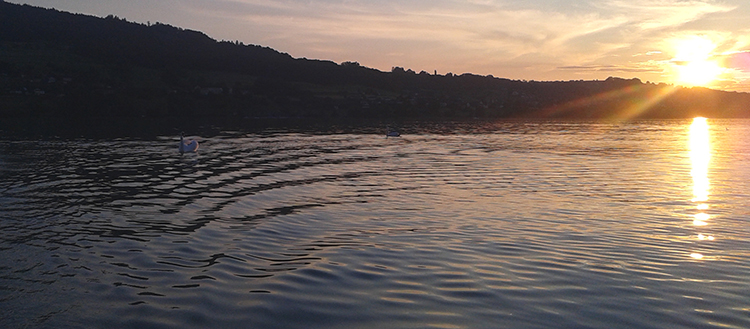Lakes could be an unsuspected source of greenhouse gases

Summer 2015, beginning of the field study on Lake Hallwil, in the Swiss canton of Argovia. (DR)
Lakes and freshwater systems account for over 20% of all methane emissions into the atmosphere. Until recently, it had been thought that methane could only be produced in oxygen-deprived environments, such as the sedimentary layers found at the bottom of lakes. In reality, surface water, even though it is mixed by the wind and rich in oxygen, produces a significant amount of methane, as a group of researchers from the University of Geneva (UNIGE), Switzerland, have recently disclosed. This phenomenon, which is still largely unknown, has been highlighted by a two-year field study designed to measure the methane concentration and production in the surface water (the top five metres) of Lake Hallwil in the Swiss canton of Argovia. The UNIGE research, which is published in Nature Communications, shows that lakes play a critical role in the methane gas cycle, where the greenhouse effect is 28 times higher than for carbon dioxide.
A number of studies have focused on measuring methane concentration in lakes with low organic matter content. Measurements have been taken at different depths, from the lake bottom to the surface water. These studies have all reported a peak methane concentration between 7 and 15 metres in the thermocline layer, where the water temperature drops sharply. Observations have especially focused on this layer, while ignoring methane production in the lake surface layer, especially the top five metres. This omission has been corrected by a team of scientists led by Daphné Donis and Daniel McGinnis, co-authors of the study and researchers in the Aquatic Physics group, F.-A. Forel Department of Environmental and Water Sciences at the UNIGE Faculty of Science.
The measurement campaign was conducted over the summers of 2015 and 2016 in Lake Hallwil with an unexpected conclusion: the mechanical accumulation of methane in the lake surface cannot explain the concentrations that the scientists observed. The mixing of the surface water creates a continuous, one-way exchange with the atmosphere, and the methane escapes from the water into the air. The concentration should, therefore, be much lower, and the rates observed can only be explained by the fact that the gas is being produced in the surface layer. «Something huge is going on in the surface water, and nobody has been paying attention to it so far,» says McGinnis. A similar phenomenon has been reported in the surface of the oceans but on a smaller scale, about a thousand times lower. In short, though there is less area covered by freshwater than oceans, the contribution from lakes is the same.
Methane, lakes and cows
Ninety percent of methane emissions from Lake Hallwil – about 25 tonnes a year – are thought to be produced in the top five metres of the water column, and the research results suggest that the same phenomenon occurs in other lakes with similar characteristics. Although most of the methane formed in the sediment disappears through oxidation as it rises in the lake water, the same is not true for the methane generated near the surface: this escapes directly into the atmosphere. It is possible, then, that lakes could be enormous producers of methane, much larger producers, in fact, than previously estimated.
Cattle flatulence is a major source of methane gas. Since it was first documented, bovine flatulence has been used as an informal measure of methane emissions, and the UNIGE researchers invited the comparison: Lake Hallwil, with a surface area of about ten square kilometres, generates as much methane every year as a herd of 240 cows.
The UNIGE researchers cite the possible role of algae as one hypothesis to explain the production of methane close to the lake’s surface. They also mention the potential presence of anaerobic niches, oxygen-deprived environments that might act as «methane incubators». Another hypothesis is that the bacteria that take part in the methane oxidation process are inhibited by light, and their action would, therefore, be non-existent near the surface. «The methane produced in lake surface water is probably the result of several factors, and may not even be produced by bacteria. It could be the by-product of another, yet unknown process» states McGinnis. More research is therefore clearly needed.
Contact: Daniel McGinnis, +41 22 379 07 92
21 Nov 2017
